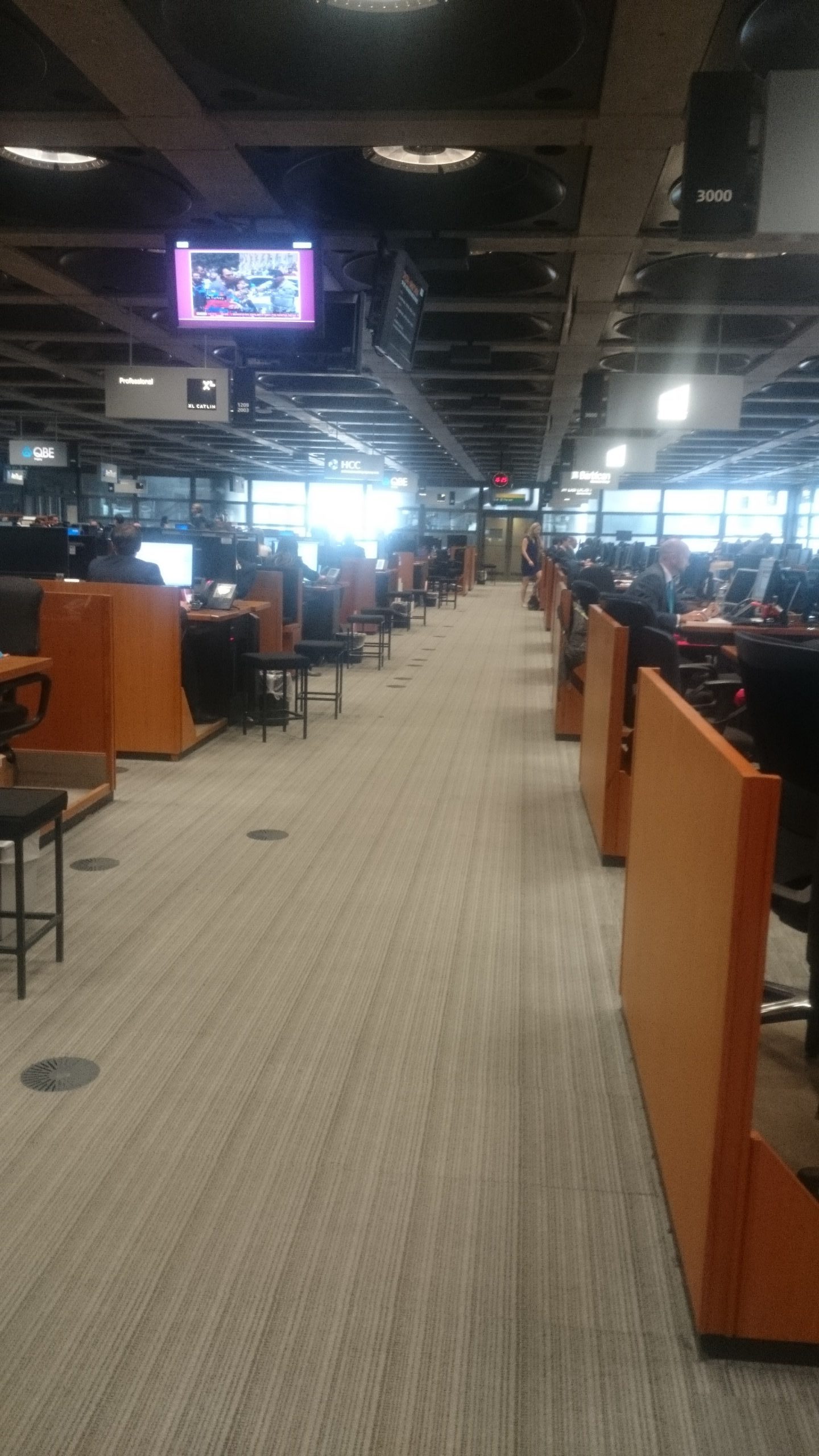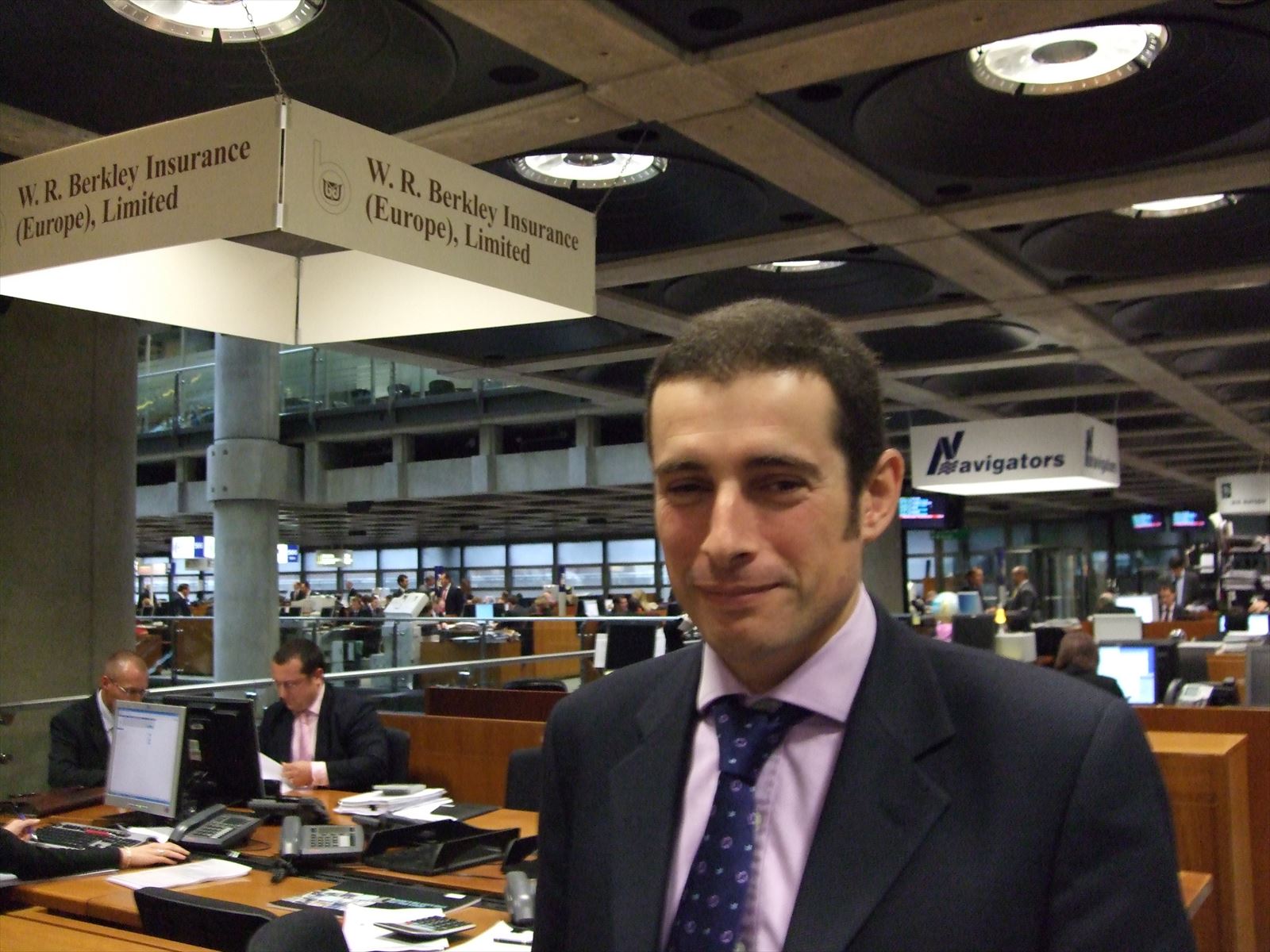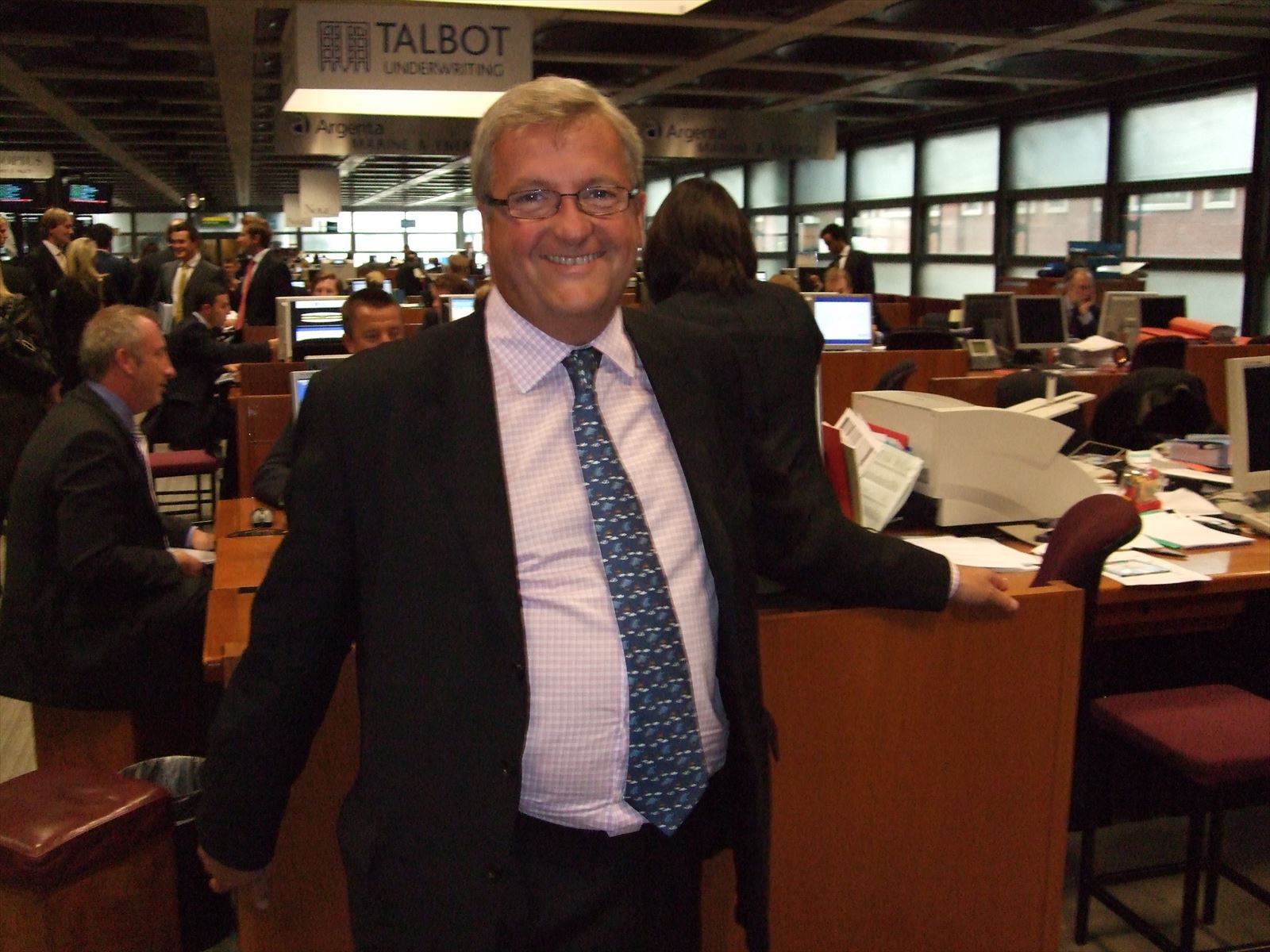キャプティブ 2020.04.16
CA13 ロンドン・マーケット(保険・再保険市場)The London market (insurance and reinsurance market)
目次
Copyright © Shinichiro Hatani 2020 All rights reserved
For those who prefer to read this column in English, the Japanese text is followed by a British English translation, so please scroll down to the bottom of the Japanese text.
昨年9月、ロンドンに出張したとき、業務提携先の保険ブローカー(保険仲立人)の事務所を訪問、いつものように「会議室」を「グローバル・リンクの臨時ロンドン事務所」として使わせてもらいながら、「あれ、トニーは?」と尋ねたことがある。そうしたら、「急ぎの案件があったでしょう、あの件でマーケットに行っている、もうすぐ帰ってくるから」との答えが返ってきたのを思い出す。
いま、新型コロナ・ウイルスの感染拡大によって、ロイズを中心にしたその「ロンドン・マーケット」が大きく揺れている。「見せることはまず無い、案件に関する重たい書類」を抱えながら、アンダーライターを訪問、対面で引受条件を300年間決めてきた伝統が、「感染拡大を防ぐため、現在、非対面取引を求められている」ためであり、また今後も「取引を非対面の方向に変えていくことを余儀なくされる可能性が高いから」である。300年の伝統が大きく変わる可能性が高い。

1.市場(マーケット)
「モノを売り買いする場所」が市場(マーケット)である。築地市場は豊洲に移転して豊洲市場となり、水産物、青果物の売り買いをおこなっている。上記の保険の売り買いをおこなっている「マーケット」とは、主にロイズ(Lloyd’s of London)を指す言葉であるが、ロイズを中心に世界中の何千という数の保険会社や保険ブローカー(保険仲立人)が事務所を構えているため、シティ(ロンドン金融街)の一角、「保険ブロック」全体が「マーケット」とも言われる。これが、いわゆる「ロンドン・マーケット」である。
保険の売り買いの仲介をするのが、保険ブローカー(保険仲立人)である。「保険市場のなかの保険市場」と言われるロイズの取引場所(アンダーライティング・ルーム)は、上の写真のようになっている。
メインフロアのGround Floor (地上階)は、Marine(マリン:海上保険)のアンダーライターのシンジケートが占有している。保険の引受けの可否、条件を決めるアンダーライターが社員として所属する組織体が「シンジケート」である。「シンジケート=保険を引受ける会社=保険会社」と考えても差し支えないが、保険会社そのものではなく、保険会社がロイズのなかで保険を引き受ける際に設立する組織体である。
First Floor(英国式の1階=日本式では2階となる)には、Non-Marine(ノンマリン:海上保険以外の種目すべて)のシンジケートとその引受人であるアンダーライターが「店を構えて」いる。
Second Floor(英国式の2階=日本式では3階となる)は、Company Marketといい、保険会社のアンダーライターが所在する場所である。筆者も25年前、米国のCIGNA Corporationに勤務した時、ロンドンに3ヶ月間研修出張をしたが、その際午前10時から4時までアンダーライターとして勤務した場所がこのSecond Floorであり、その前と後の時間帯は、ロイズ近くのCIGNAのビルで準備仕事や終了後のまとめをしていた。
このシンジケートが、ロイズのなかで開いている「店のこと」をBox(ボックス)と呼ぶ。終日Boxにいるアンダーライターは背もたれのある椅子に座り、上の写真でも分るとおり、通路側にある背もたれのない椅子にはそのアンダーライターとリスクの引受交渉に来たブローカーが座る。
「なぜ、背もたれがないか」、それは「長時間アンダーライターを独占しない、させない」というロイズの不文律に起因すると聞く。それが証拠に、ロイズのなかでアンダーライターと15分を超えて話しをしている「素人のブローカー」がいた場合、アンダーライターからやんわりと、もしくは直裁に「退席を求められる」ことがある。そのような「素人のブローカー」が次に来たときに、アンダーライターがどういう態度で接するかは自明の理であろう。
2.再保険市場
再保険とは、「保険会社(もしくは同様の保険機構)が引受けたリスクを別の保険会社(もしくは同様の保険機構)にリスクを移転するために保険を掛けることをいい、引受けた保険を「再」び「保険」を掛けるから、「再保険」」という。
世界経済の中心は、損害保険分野を除いてすべて産業が、第二次世界大戦以降、英国を中心とするヨーロッパより米国に移り、米国を中心にして資本主義の経済活動が行われている、しかし保険、特に損害保険では全く異なる、損害保険の世界の中心地はいまだにロンドンである。
保険数理士(アクチュアリー)の計算に基づき保険を引き受ける生命保険分野では、「想定外の損害」が起きることはほとんどと無いため、生命保険分野において、再保険は一般的ではないが、損害保険分野では事業の存亡に関わる可能性のある巨大リスクを引き受けるため、「再保険の手配」は最重要戦略となっている。その再保険手配の地が、前述のロイズ(Lloyd’s of London)を中心とした英国ロンドンの金融街、シティである。
保険契約者が保険会社から保険を購入することによって、「移転されたリスク」は、その更なるリスク移転(リスクヘッジ)のため再保険会社等が構成する再保険市場に移転されることになるが、この動きと流れはあたかも蜘蛛の巣のよう多方面に移転されていく。このため、保険会社(元受保険会社)から再保険市場へのリスクの移転は、リスクの移転ではなくリスクの分散と呼ばれることが多い。
保険契約を保険契約者から引き受けた元受保険会社は、再保険専門の保険会社に再保険契約をすることが再保険の中心であるが、再保険専門の再保険会社だけが再保険事業を行っているのではない。再保険の引受部門(子会社)を有する元受保険会社グループが再保険を引き受けているケースも多い。
したがって、再保険市場は、再保険専門保険会社に限らない多数の保険会社(保険機構)が取引をする市場となっている。そのため、世界中の保険関係者にとってみると、再保険会社であろうと元受保険会社であろうと、「再保険を引受けてくれるプレーヤーが、世界で一番多く一箇所に集中している場所」での取引が、効率的にビジネスを進めることができるため好まれる。その場所、世界の再保険市場がロンドンなのである。
3.アンダーライター(引受権限保持者)
アンダーライターが別のシンジケート(別の保険会社)に転職すれば、顧客も一緒にそのシンジケートに移っていくことは非常に多い。それほど、「アンダーライターと顧客(保険契約者)との関係は深い」と言える。



筆者が、この20年以上親しく付き合ってきたロイズのアンダーライター達(一部)である。このような、長年のロンドンマーケットとの関係から、グローバル・リンクが特に重視している点は、キャプティブが再保険を契約するロンドン保険市場のアンダーライターと強い信頼関係を築くことである。
グローバル・リンクは、「アンダーライターにとって何が必要なのか、どういう情報があればより良い条件、より低廉な保険料を出しやすいのか」という視点に立ち、「的確なリスク判断」に資する情報、彼らが必要とするきめ細かなサポートを積極的に提供して、世界の保険市場で最も信頼される世界最大級の再保険会社やロイズのいくつものシンジケートのアンダーライター達と強固な信頼関係を構築している。
このことによって、企業が必要とする高い補償水準や広範な補償内容を高い費用対効果で可能にする、「ソリューション・キャプティブ®」プログラムの実現を可能にしているのである。
今回のまとめ
日本では「保険契約者は『保険会社』と保険契約をおこない、保険会社の『個人』との保険契約」ではない。しかし、欧米では全く逆である。「個人と個人の関係が最優先される」風土であり、保険会社、保険引受シンジケートより、「アンダーライター個人」との関係が重視されるのが普通である。
このことから、「キャプティブからの再保険の手配を『会社対会社レベル』ではなく『個人レベル』までにしているか否かが重要な分岐点である」ということが理解されるであろう。再保険を手配する「再保険ブローカー任せ」にしているか、それとも「一歩踏み込んで、実際に保険を引受ける再保険会社のアンダーライター達と個人的な関係にまで関係を深化させているか」、このいずれかによって、万が一の場合、特に保険金の支払いの時に大きな差が出る可能性が高い。
これは筆者が長年ロンドン・マーケットとビジネスを展開してきて得た「知恵」である。だからこそ、グローバル・リンクでは、頻繁にロンドン・マーケットを訪れ、アンダーライター達との個人的な関係を更に深化させていくことに注力しているのである。
筆者は、損害保険会社の経営コンサルタント時代、長年にわたって「再保険の補償」をロンドンマーケットから提供され、高い競合優位性の有る商品を開発してきた経験によって培われた強固な信頼関係のもと、日本の元受保険会社が驚くほどの再保険料水準と補償内容で、保険契約者(キャプティブ)が再保険を購入できている結果となっているのではないかと考えている。
世界的なコロナ・ウイルスの感染拡大によって、海外出張はおろか外出さえ制限される状況であるが、筆者はロンドンへの出張のフライトを予約した。パンデミックの終息を10月とその希望を持って読み、その後半年間の「復帰必要期間」を考え、来年3月中旬とした。そのとき「300年の伝統」はどうなっているのであろうか。
執筆・翻訳者:羽谷 信一郎
English Translation
Captive 13-The London market (insurance and reinsurance market)
On a business trip to London last year, I visited the office of the insurance broker with whom I work, and as usual, I was allowed to use the “conference room” as “Global Link’s temporary London office” while asking, “Hey, where’s Tony? I asked her once. I remember her reply, “We had an urgent matter to deal with, he’s in the market to deal with that, and he’ll be back soon”.
Now, the spread of the new coronavirus has shaken up that “London market” around Lloyds of London. The 300-year tradition of visiting underwriters and deciding the terms of underwriting face-to-face, with “heavy paperwork on deals that is rarely shown” is now and will continue to be “forced to turn deals in a non-face-to-face direction” because “non-face-to-face deals are now required to prevent the spread of infection There is a high possibility that 300 years of tradition will change significantly.
Now, the spread of the new coronavirus has shaken up that “London market” around Lloyds of London. The 300-year tradition of visiting underwriters and deciding the terms of underwriting face-to-face, with “heavy paperwork on deals that is rarely shown” is now and will continue to be “forced to turn deals in a non-face-to-face direction” because “non-face-to-face deals are now required to prevent the spread of infection There is a high possibility that 300 years of tradition will change significantly.
1. Markets
A market is a place to buy and sell goods. The Tsukiji Market was relocated to Toyosu, where marine products, fruit and vegetables are bought and sold. The “market” where insurance is bought and sold is mainly Lloyd’s of London, but it is also home to thousands of insurance companies and insurance brokers from around the world. The entire “insurance block” (part of the financial district) is also known as the “market”. This is the so-called “London Market”.
Insurance brokers act as intermediaries for buying and selling insurance. The “insurance market within an insurance market”, Lloyds’ trading venue (the underwriting room) is pictured above.
The Ground Floor of the main floor is occupied by a syndicate of Marine (marine insurance) underwriters. The Syndicate is the body to which the underwriters belong as employees who decide on the conditions of underwriting.Syndicate” is not an insurance company itself, but an organization established by an insurance company or a company wishing to invest to underwrite insurance in Lloyd’s of London.
On the First Floor (the first floor in the English style = the second floor in the Japanese style), the Non-Marine (all disciplines except marine insurance) syndicates and their underwriters, the underwriters, “set up shop”.
The Second Floor (the second floor in British style=the third floor in the Japanese style) is called Company Market and is where the underwriters of the insurance companies are located. When I was working for CIGNA Corporation in the US, I went to London for 3 months for training 25 years ago, and I worked as an underwriter from 10 a.m. to 4 p.m. at the Second Floor. The hours before and after I spent in the CIGNA building near Lloyds doing prep work and wrapping up afterwards.
The “shop” that a syndicate keeps open in Lloyd’s is called Box. The underwriters in the Box all day sit in a chair with a backrest, and as you can see in the picture above, the broker who came to negotiate the underwriting of the risk sits in a backless chair on the side of the aisle side.
We are told that the reason for the lack of a backrest is due to the Lloyds’ of London unwritten rule of “not monopolizing or letting the broker monopolize the underwriter for long periods of time. The evidence of this is that if there is an “amateur broker” in Lloyd’s of London who is talking to an underwriter for more than fifteen minutes, the underwriter may be asked to leave the room, either softly or directly. It is obvious what kind of attitude the underwriter will have when such an “amateur broker” comes next time.
2. The Reinsurance Market
Reinsurance refers to “insuring a risk that has been underwritten by an insurance company (or similar insurance mechanism) in order to transfer the risk to another insurance company (or similar insurance mechanism),” and as called “re”insurance because of “re” insuring the underwritten insurance.
The center of the world’s economy, with the exception of the property and casualty insurance sector, all industries have moved to the United States since the Second World War, rather than Europe, led by the United Kingdom, and the United States is the center of capitalist economic activity, but in insurance, especially property and casualty insurance, the center of the world of property and casualty insurance is still London.
Reinsurance is not common in life insurance, as “unexpected losses” are rare in the field of life insurance, where insurance is underwritten on the basis of actuarial calculations, but in property/casualty insurance, where huge risks are taken on that can be life-threatening to the business, the “reinsurance Arrangements” has become the most important strategy. Reinsurance arrangements are made in the City of London, the financial district of London in the UK, where the aforementioned Lloyd’s of London is located.
When a policyholder purchases insurance from an insurance company, the transferred risk is transferred to the reinsurance market for further risk transfer (risk hedging), and this movement and flow is like a spider’s web. For this reason, the transfer of risk from insurers (primary insurers) to the reinsurance market is often referred to as risk diversification rather than risk transfer.
Although the primary insurers that underwrite insurance policies from policyholders are central to reinsurance, they are not the only reinsurance companies that specialize in reinsurance business. In many cases, reinsurance is underwritten by a group of primary insurers with reinsurance underwriting divisions (subsidiaries).
The reinsurance market is therefore a market in which a large number of insurance companies (insurance organizations), not just specialist reinsurance companies, transact. As a result, insurers around the world prefer to do business with the largest number of reinsurance players in one place, whether they are reinsurers or primary insurers, because it allows them to do business more efficiently. That place, the world’s reinsurance market, is London.
When an underwriter moves to another syndicate (another insurance company), very often the clients move with him to that syndicate. The relationship between underwriters and clients (policyholders) is so close.
The above pictures are some of the Lloyd’s underwriters with whom I have had a close relationship over the past 20 years. Because of this long-standing relationship with the London market, Global Link places particular emphasis on building strong relationships with underwriters in the London insurance market, where the captives sign up for reinsurance.
Global Link has established strong relationships with some of the world’s largest and most trusted reinsurers and underwriters in some of the Lloyd’s of London syndicates in the world’s largest reinsurance market, by proactively providing the information and support they need to make the right risk decisions, based on what the underwriters need and what information would help them get better terms and lower premiums.
This enables the Solution Captive® program to deliver the high levels and breadth of coverage that companies need at a cost effective level.
Summary of this issue
In Japan, the policyholder makes an insurance contract with an ‘insurance company’ and not with an ‘individual’ of the insurance company. In Europe and the United States, however, it’s quite the opposite. The culture is one in which “the relationship between the individual and the individual is paramount” and the relationship with the “individual underwriter” is usually more important than the insurance company and the insurance underwriting syndicate.
From this, it will be understood that “the key juncture is whether or not reinsurance is arranged from the captive to the ‘individual’ level rather than the ‘company to company level’. Either you are “leaving it up to the reinsurance broker” to arrange the reinsurance, or you are “taking it a step further and deepening your relationship with the reinsurance company underwriters who actually underwrite the insurance”, either of which could make a big difference in the unlikely event of a claim, especially when High.
This is the “wisdom” that I have gained from doing business with London Market over the years. This is why Global Link frequently visits the London market and focuses on developing personal relationships with underwriters.
The author has developed strong relationships with London market “reinsurance coverage” over many years as a management consultant for property and casualty insurers, developing products with a strong competitive advantage, which has resulted in Japanese captives being able to purchase reinsurance at premiums and coverages that are surprisingly competitive for Japanese primary insurers.
Although the global spread of the coronavirus has limited my ability to travel abroad, or even out of the country, I booked a flight to London for a business trip. Reading the end of the pandemic to be in October and its hopefulness, and considering the six-month “return to work” period that would follow, I set the date for mid-March of next year. What will happen to the “300-year tradition” then?
Author/translator: Shinichiro Hatani

